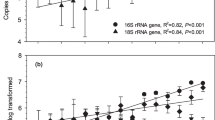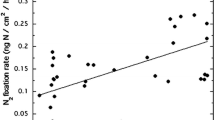Abstract
Past work in recently deglaciated soils demonstrates that microbial communities undergo shifts prior to plant colonization. To date, most studies have focused on relatively ‘long’ chronosequences with the ability to sample plant-free sites over at least 50 years of development. However, some recently deglaciated soils feature rapid plant colonization and questions remain about the relative rate of change in the microbial community in the unvegetated soils of these chronosequences. Thus, we investigated the forelands of the Mendenhall Glacier near Juneau, AK, USA, where plants rapidly establish. We collected unvegetated samples representing soils that had been ice-free for 0, 1, 4, and 8 years. Total nitrogen (N) ranged from 0.00∼0.14 mg/g soil, soil organic carbon pools ranged from 0.6∼2.3 mg/g soil, and both decreased in concentration between the 0 and 4 yr soils. Biologically available phosphorus (P) and pH underwent similar dynamics. However, both pH and available P increased in the 8 yr soils. Nitrogen fixation was nearly undetectable in the most recently exposed soils, and increased in the 8 yr soils to ∼5 ng N fixed/cm2/h, a trend that was matched by the activity of the soil N-cycling enzymes urease and β-l,4-N-acetyl-glucosa-minidase. 16S rRNA gene clone libraries revealed no significant differences between the 0 and 8 yr soils; however, 8 yr soils featured the presence of cyanobacteria, a division wholly absent from the 0 yr soils. Taken together, our results suggest that microbes are consuming allochtonous organic matter sources in the most recently exposed soils. Once this carbon source is depleted, a competitive advantage may be ceded to microbes not reliant on in situ nutrient sources.
Similar content being viewed by others
References
Alexander, E.B. and R. Burt. 1996. Soil development on moraines of Mendenhall Glacier, southeast Alaska.1. The moraines and soil morphology. Geoderma 72, 1–17.
Allison, V.J., L.M. Condron, D.A. Peltzer, S.J. Richardson, and B.L. Turner. 2007. Changes in enzyme activities and soil microbial community composition along carbon and nutrient gradients at the Franz Josef chronosequence, New Zealand. Soil Biol. Biochem. 39, 1770–1781.
Altschul, S.F., W. Gish, W. Miller, E.W. Myers, and D.J. Lipman. 1990. Basic local alignment search tool. J. Mol. Biol. 215, 403–410.
Ashelford, K.E., N.A. Chuzhanova, J.C. Fry, A.J. Jones, and A.J. Weightman. 2006. New screening software shows that most recent large 16S rRNA gene clone libraries contain chimeras. Appl. Environ. Microbiol. 72, 5734–5741.
Bardgett, R.D., A. Richter, R. Bol, M.H. Garnett, R. Baumler, X.L. Xu, E. Lopez-Capel, D.A.C. Manning, P.J. Hobbs, I.R. Hartley, and W. Wanek. 2007. Heterotrophic microbial communities use ancient carbon following glacial retreat. Biol. Lett. UK 3, 487–490.
Belnap, J. 1996. Soil surface disturbances in cold deserts: Effects on nitrogenase activity in cyanobacterial-lichen soil crusts. Biol. Fert. Soils 23, 362–367.
Bergman, B., J.R. Gallon, A.N. Rai, and L.J. Stal. 1997. N2 fixation by non-heterocystous cyanobacteria. FEMS Microbiol. Rev. 19, 139–185.
Burt, R. and E.B. Alexander. 1996. Soil development on moraines of Mendenhall Glacier, southeast Alaska.2. Chemical transformations and soil micromorphology. Geoderma 72, 19–36.
Chapin, F.S., L.R. Walker, C.L. Fastie, and L.C. Sharman. 1994. Mechanisms of primary succession following deglaciation at Glacier Bay, Alaska. Ecol. Monogr. 64, 149–175.
Chin, C.C. and G. Gorin. 1966. Urease.7. Some observations on assay method of Sumner. Anal. Biochem. 17, 60–65.
Cleveland, C.C. and D. Liptzin. 2007. C: N: P stoichiometry in soil: is there a “Redfield ratio” for the microbial biomass? Biogeochemistry 85, 235–252.
Crocker, R.L. and B.A. Dickson. 1957. Soil development on the recessional moraines of the Herbert and Mendenhall Glaciers, Southeastern Alaska. J. Ecol. 45, 169–185.
Cross, A.F. and W.H. Schlesinger. 1995. A literature review and evaluation of the Hedley Fractionation — Applications to the biogeochemical cycle of soil phosphorus in natural ecosystems. Geoderma 64, 197–214.
Deiglmayr, K., L. Philippot, D. Tscherko, and E. Kandeler. 2006. Microbial succession of nitrate-reducing bacteria in the rhizosphere of Poa alpina across a glacier foreland in the Central Alps. Environ. Microbiol. 8, 1600–1612.
Del Moral, R., J.H. Titus, and A.M. Cook. 1995. Early primary succession on Mount St-Helens, Washington, USA. J. Veg. Sci. 6, 107–120.
DeSantis, T.Z., P. Hugenholtz, N. Larsen, M. Rojas, E.L. Brodie, K. Keller, T. Huber, D. Dalevi, P. Hu, and G.L. Andersen. 2006. Greengenes, a chimera-checked 16S rRNA gene database and workbench compatible with ARB. Appl. Environ. Microbiol. 72, 5069–5072.
Duc, L., M. Noll, B.E. Meier, H. Burgmann, and J. Zeyer. 2009. High diversity of diazotrophs in the forefield of a receding alpine glacier. Microb. Ecol. 57, 179–190.
Hammerli, A., S. Waldhuber, C. Miniaci, J. Zeyer, and M. Bunge. 2007. Local expansion and selection of soil bacteria in a glacier forefield. Eur. J. Soil Sci. 58, 1437–1445.
Hardy, R.W.F., R.D. Holsten, E.K. Jackson, and R.C. Burns. 1968. Acetylene-ethylene assay for N2 fixation — laboratory and field evaluation. Plant Physiol. 43, 1185–1207.
Hodkinson, I.D., S.J. Coulson, J. Harrison, and N.R. Webb. 2001. What a wonderful web they weave: spiders, nutrient capture and early ecosystem development in the high Arctic — some counter-intuitive ideas on community assembly. Oikos 95, 349–352.
Hodkinson, I.D., N.R. Webb, and S.J. Coulson. 2002. Primary community assembly on land — the missing stages: why are the heterotrophic organisms always there first? J. Ecol. 90, 569–577.
Huber, T., G. Faulkner, and P. Hugenholtz. 2004. Bellerophon: a program to detect chimeric sequences in multiple sequence alignments. Bioinformatics 20, 2317–2319.
Jones, M.L.M., A. Sowerby, D.L. Williams, and R.E. Jones. 2008. Factors controlling soil development in sand dunes: evidence from a coastal dune soil chronosequence. Plant Soil 307, 219–234.
Kandeler, E., K. Deiglmayr, D. Tscherko, D. Bru, and L. Philippot. 2006. Abundance of narG, nirS, nirK, and nosZ genes of denitrifying bacteria during primary successions of a glacier foreland. Appl. Environ. Microbiol. 72, 5957–5962.
Kastovska, K., J. Elster, M. Stibal, and H. Santruckova. 2005. Microbial assemblages in soil microbial succession after glacial retreat in Svalbard (high Arctic). Microb. Ecol. 50, 396–407.
King, A.J., A.F. Meyer, and S.K. Schmidt. 2008. High levels of microbial biomass and activity in unvegetated tropical and temperate alpine soils. Soil Biol. Biochem. 40, 2605–2610.
Krebs, C.J. 2001. Ecology: the experimental analysis of distribution and abundance. Benjamin Cummings, San Francisco, USA.
Kuo, S. 1996. Phosphorus, p. 869–919. In D.L. Sparks (ed.), Methods of Soil Analysis. Soil Science Society of America, Inc., Madison, Wisconsin, USA.
Lane, D.J. 1991. 16S/23S rRNA Sequencing, p. 115–175. In E. Stackebrandt and M. Goodfellow (eds.), Nucleic acid techniques in bacterial systematics. John Wiley & Sons Ltd, West Sussex, USA.
Ley, R.E., M. Hamady, C. Lozupone, P.J. Turnbaugh, R.R. Ramey, J.S. Bircher, M.L. Schlegel, T.A. Tucker, M.D. Schrenzel, R. Knight, and J.I. Gordon. 2008. Evolution of mammals and their gut microbes. Science 320, 1647–1651.
Lozupone, C., M. Hamady, and R. Knight. 2006. UniFrac — An online tool for comparing microbial community diversity in a phylogenetic context. BMC Bioinformatics 7.
Martin, A.P. 2002. Phylogenetic approaches for describing and comparing the diversity of microbial communities. Appl. Environ. Microbiol. 68, 3673–3682.
Motyka, R.J., S. O’Neel, C.L. Connor, and K.A. Echelmeyer. 2003. Twentieth century thinning of Mendenhall Glacier, Alaska, and its relationship to climate, lake calving, and glacier run-off. Global Planet Change 35, 93–112.
Nemergut, D.R., S.P. Anderson, C.C. Cleveland, A.P. Martin, A.E. Miller, A. Seimon, and S.K. Schmidt. 2007. Microbial community succession in an unvegetated, recently deglaciated soil. Microb. Ecol. 53, 110–122.
Nemergut, D.R., E.K. Costello, A.F. Meyer, M.Y. Pescador, M.N. Weintraub, and S.K. Schmidt. 2005. Structure and function of alpine and arctic soil microbial communities. Res. Microbiol. 156, 775–784.
Nemergut, D.R., A.R. Townsend, S.R. Sattin, K.R. Freeman, N. Fierer, J.C. Neff, W.D. Bowman, C.W. Schadt, M.N. Weintraub, and S.K. Schmidt. 2008. The effects of chronic nitrogen fertilization on alpine tundra soil microbial communities: implications for carbon and nitrogen cycling. Environ. Microbiol. 10, 3093–3105.
Nicol, G.W., D. Tscherko, T.M. Embley, and J.I. Prosser. 2005. Primary succession of soil Crenarchaeota across a receding glacier foreland. Environ. Microbiol. 7, 337–347.
Noll, M. and M. Wellinger. 2008. Changes of the soil ecosystem along a receding glacier: Testing the correlation between environmental factors and bacterial community structure. Soil Biol. Biochem. 40, 2611–2619.
Ohtonen, R., H. Fritze, T. Pennanen, A. Jumpponen, and J. Trappe. 1999. Ecosystem properties and microbial community changes in primary succession on a glacier forefront. Oecologia 119, 239–246.
Reed, S.C., C.C. Cleveland, and A.R. Townsend. 2007. Controls over leaf litter and soil nitrogen fixation in two lowland tropical rain forests. Biotropica 39, 585–592.
Saiya-Cork, K.R., R.L. Sinsabaugh, and D.R. Zak. 2002. The effects of long term nitrogen deposition on extracellular enzyme activity in an Acer saccharum forest soil. Soil Biol. Biochem. 34, 1309–1315.
Schipper, L.A., B.P. Degens, G.P. Sparling, and L.C. Duncan. 2001. Changes in microbial heterotrophic diversity along five plant successional sequences. Soil Biol. Biochem. 33, 2093–2103.
Schloss, P.D. and J. Handelsman. 2005. Introducing DOTUR, a computer program for defining operational taxonomic units and estimating species richness. Appl. Environ. Microbiol. 1501–1506.
Schmidt, S.K., E.K. Costello, D.R. Nemergut, C.C. Cleveland, S.C. Reed, M.N. Weintraub, A.F. Meyer, and A.M. Martin. 2007. Biogeochemical consequences of rapid microbial turnover and seasonal succession in soil. Ecology 88, 1379–1385.
Schmidt, S.K., S.C. Reed, D.R. Nemergut, A.S. Grandy, C.C. Cleveland, M.N. Weintraub, A.W. Hill, E.K. Costello, A.F. Meyer, J.C. Neff, and A.M. Martin. 2008. The earliest stages of ecosystem succession in high-elevation (5000 metres above sea level), recently deglaciated soils. P. Roy. Soc. B-Biol. Sci. 275, 2793–2802.
Sigler, W.V., S. Crivii, and J. Zeyer. 2002. Bacterial succession in glacial forefield soils characterized by community structure, activity and opportunistic growth dynamics. Microb. Ecol. 44, 306–316.
Sigler, W.V. and J. Zeyer. 2002. Microbial diversity and activity along the forefields of two receding glaciers. Microb. Ecol. 43, 397–407.
Sprent, J.I. and J.A. Raven. 1985. Evolution of nitrogen fixing symbioses. Proc. R. Soc. Edin. B 85, 215–237.
Swofford, D.L. 2001. Phylogenetic Analysis Using Parsimony (*and Other Methods), 4th ed. Sinauer Associates, Sunderland, MA, USA.
Tiessen, H. and J.O. Moir. 1993. Characterization of available P by sequential extraction, p. 75–86. In M.R. Carter (ed.), Soil Sampling and Methods of Analysis. Canadian Society of Soil Science. Lewis Publishers, Boca Raton, FL, USA.
Tscherko, D., U. Hammesfahr, M.C. Marx, and E. Kandeler. 2004. Shifts in rhizosphere microbial communities and enzyme activity of Poa alpina across an alpine chronosequence. Soil Biol. Biochem. 36, 1685–1698.
Tscherko, D., U. Hammesfahr, G. Zeltner, E. Kandeler, and R. Bocker. 2005. Plant succession and rhizosphere microbial communities in a recently deglaciated alpine terrain. Basic Appl. Ecol. 6, 367–383.
Tscherko, D., J. Rustemeier, A. Richter, W. Wanek, and E. Kandeler. 2003. Functional diversity of the soil microflora in primary succession across two glacier forelands in the Central Alps. Eur. J. Soil Sci. 54, 685–696.
Vitousek, P.M. 2004. Hawai’i as a Model System. Princeton University Press, Princeton, NJ, USA.
Weintraub, M.N., L.E. Scott-Denton, S.K. Schmidt, and R.K. Monson. 2007. The effects of tree rhizodeposition on soil exoenzyme activity, dissolved organic carbon, and nutrient availability in a subalpine forest ecosystem. Oecologia 154, 327–338.
White, C.C., M.S. Cresser, and S.J. Langan. 1996. The importance of marine-derived base cations and sulphur in estimating critical loads in Scotland. Sci. Total Environ. 177, 225–236.
**e, C.H. and A. Yokota. 2006. Zoogloea oryzae sp. nov., a nitrogen-fixing bacterium isolated from rice paddy soil, and reclassification of the strain ATCC 19623 as Crabtreella saccharophila gen. nov., sp. nov. Int. J. Syst. Evol. Microbiol. 56, 619–624.
Author information
Authors and Affiliations
Corresponding author
Rights and permissions
About this article
Cite this article
Sattin, S.R., Cleveland, C.C., Hood, E. et al. Functional shifts in unvegetated, perhumid, recently-deglaciated soils do not correlate with shifts in soil bacterial community composition. J Microbiol. 47, 673–681 (2009). https://doi.org/10.1007/s12275-009-0194-7
Received:
Accepted:
Published:
Issue Date:
DOI: https://doi.org/10.1007/s12275-009-0194-7




